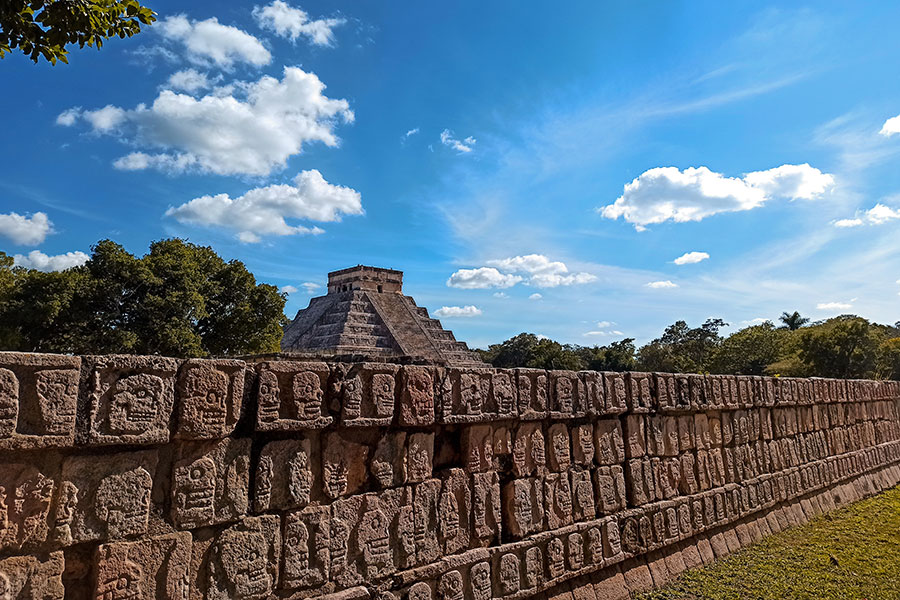Week 1 | Week 2 | Week 3 | Week 4 | Week 5
1.11

Chichén-Itzá, Yucatan, Mexico, Photo by Alexis Mora Angulo on Unsplash
Case study: the Maya: collapse or adaptation?
In many parts of the world, climate change means increasingly regular and severe droughts which endanger life and the supply of water and food. Like other natural disasters, droughts are not new to human societies. To learn about leadership in unpredictable climates, we can examine how past agro-urban societies organised and adapted.
Mayan city states are relevant as examples because these cities were comparable in size to ours today, with the largest housing up to 120 thousand people (almost as large as Uppsala) before 800 C.E. [1]. As Ekblom described, Maya cities were “green cities” where the majority of the population were farmers producing food within the town. Agricultural knowledge helped these city states to prosper for around two thousand years [3].
Historians often focus on the mystery of the Maya collapse, when citizens apparently abandoned powerful cities and their kings vanished. We know that at this time (800-950 C.E.) there were a series of severe droughts, and this correlation suggests that these cities were not equipped for extreme environmental change. However, archeologists and anthropologists Lucero et al. point out that there were settlements without kings along the Belize River where farmers survived, undisrupted, even as subjects abandoned their inflexible monarchies elsewhere [2]. While the “political system collapsed; the average Maya endured, and still do at present” [2]. Looking at the history of ordinary people, as opposed to powerful individuals, suggests that the political rigidity of royal centres in the face of water shortages was a greater factor in their collapse than their agricultural methods.
Water management
Maya people designed systems of rain capture, using channels and reservoirs [3]. These also acted as alternative water sources to diseased rivers [2]. Early reservoirs seemed to have suffered from evaporation and silting, perhaps contributing to the abandonment of early centres such as El Mirador and Nakbe by 150 C.E.. Lucero et al. estimate that later water systems, such as at the city of Tikal, could provide for 45-62 thousand people all year round. These massive reservoir systems would be vulnerable to toxins and diseases, and had to be carefully protected, some with a roof of limestone [4].
Maya cities survived a millennium of yearly droughts in part because they understood their wetland environment and created artificial wetlands to filter their reservoirs [2]. They cultivated pondweed and small plants which cohabit with bacteria and algae. In the still water of the reservoirs, the bacteria fed on parasite spores and, together with the plants, absorbed nitrogen and phosphorus build-up. Waterlilies were a common motif in Maya decoration, and likely acted as an indicator of clean water because they do not grow in acidic or high-calcium conditions. Lily pads’ shade prevented proliferation of algae and gave cover to biological control species like fish and dragonflies [2].
Some reservoirs were lined with clay [2] to prevent calcium dissolving from the rock into the standing water. Such careful management suggests that Mayan rulers were experts in water management and experienced in dealing with drought. So why did their citizens feel they had to leave?
The Mayan Collapse?
In Ekblom’s video, she says that “you can also choose to see history at those moments in time where it could’ve been different”. The collapse of Mayan cities is one such example of when events could perhaps have gone another way if people had made different decisions. Lucero et al. suggest that when successive droughts hit the Mayan cities of Tikal, Calakmul, Caracol and Naranjo, the kings invested in monuments and ceremonies to appease the gods and the ancestors, rather than taking emergency, practical action [2]. The kings may have been overly reliant on evaporating reservoirs to maintain their power and monopoly on water.
Their subjects left to protect themselves: “farmers adapted, kings did not.” Some farmers, experts in agro-ecology, adapted to the new situation and organised as a community. They created multiple avenues for subsistence and began using varied water sources, including rivers, lakes and abandoned reservoirs. They migrated rather than staying in thirst.
Today, rural Mayan communities in Chiapas and the Guatemalan highlands have water user associations, which democratically manage how water and water-related labour is distributed [3].
Lucero et al. write:
Maya kings used the same rituals that had served them in the past in the hope that conditions would change; they did not. The same is true for global climate change. We know global climate change will not end anytime soon, so it is up to individuals, families, and communities to act now and not wait for conditions to change. [2]
References
- Masson M. A. (2012). Maya collapse cycles. Proceedings of the National Academy of Sciences of the United States of America, 109(45), 18237–18238. https://doi.org/10.1073/pnas.1213638109
- Lucero, L.J., Gunn, J.D. & Scarborough, V.L. (2011). Climate Change and Classic Maya Water Management, Water (Basel), vol. 3, no. 2, pp. 479-494.
- Wyatt, A.R. (2014). The scale and organization of ancient Maya water management, Wiley interdisciplinary reviews. Water, vol. 1, no. 5, pp. 449-467.
- University of Bonn. (2010). Mayan water reservoir in Mexican rainforest: Archaeologists find huge artificial lake with ceramic-lined floor. ScienceDaily. Retrieved October 29, 2022 from www.sciencedaily.com/releases/2010/08/100826083803.htm
See also
- Vansintjan, A. (2021). Urban Fish Ponds: Low-tech Sewage Treatment for Towns and Cities. Low Tech Magazine. https://www.lowtechmagazine.com/2021/03/urban-fish-ponds-low-tech-sewage-treatment-for-towns-and-cities.html
- Scott, J.C. (2009). The art of not being governed: an anarchist history of upland Southeast Asia, Yale University Press: New Haven & London.
© CEMUS and Uppsala University
